Evidence Based Practice - PDF
VerifiedAdded on 2021/06/15
|18
|4028
|88
AI Summary
Contribute Materials
Your contribution can guide someone’s learning journey. Share your
documents today.
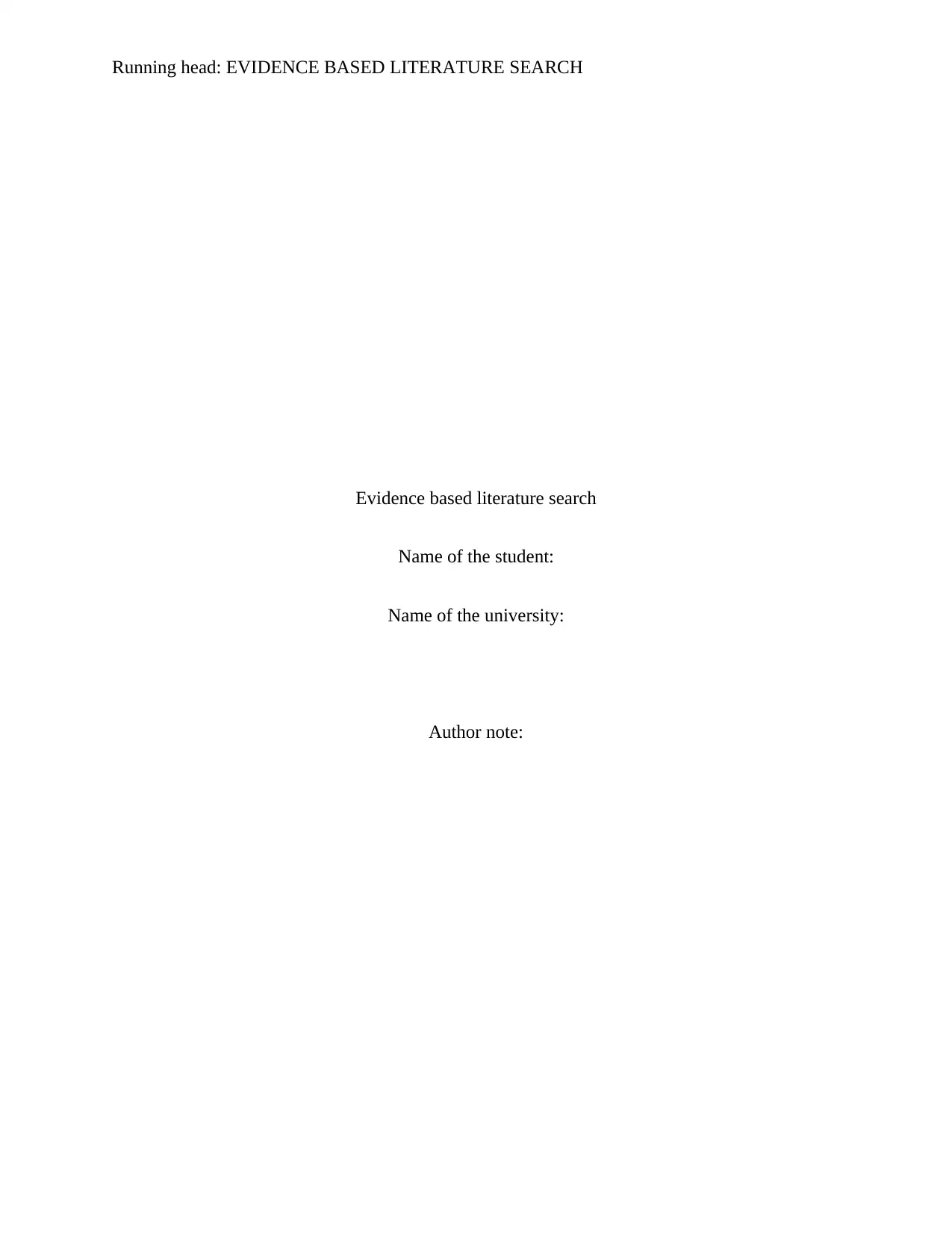
Running head: EVIDENCE BASED LITERATURE SEARCH
Evidence based literature search
Name of the student:
Name of the university:
Author note:
Evidence based literature search
Name of the student:
Name of the university:
Author note:
Secure Best Marks with AI Grader
Need help grading? Try our AI Grader for instant feedback on your assignments.
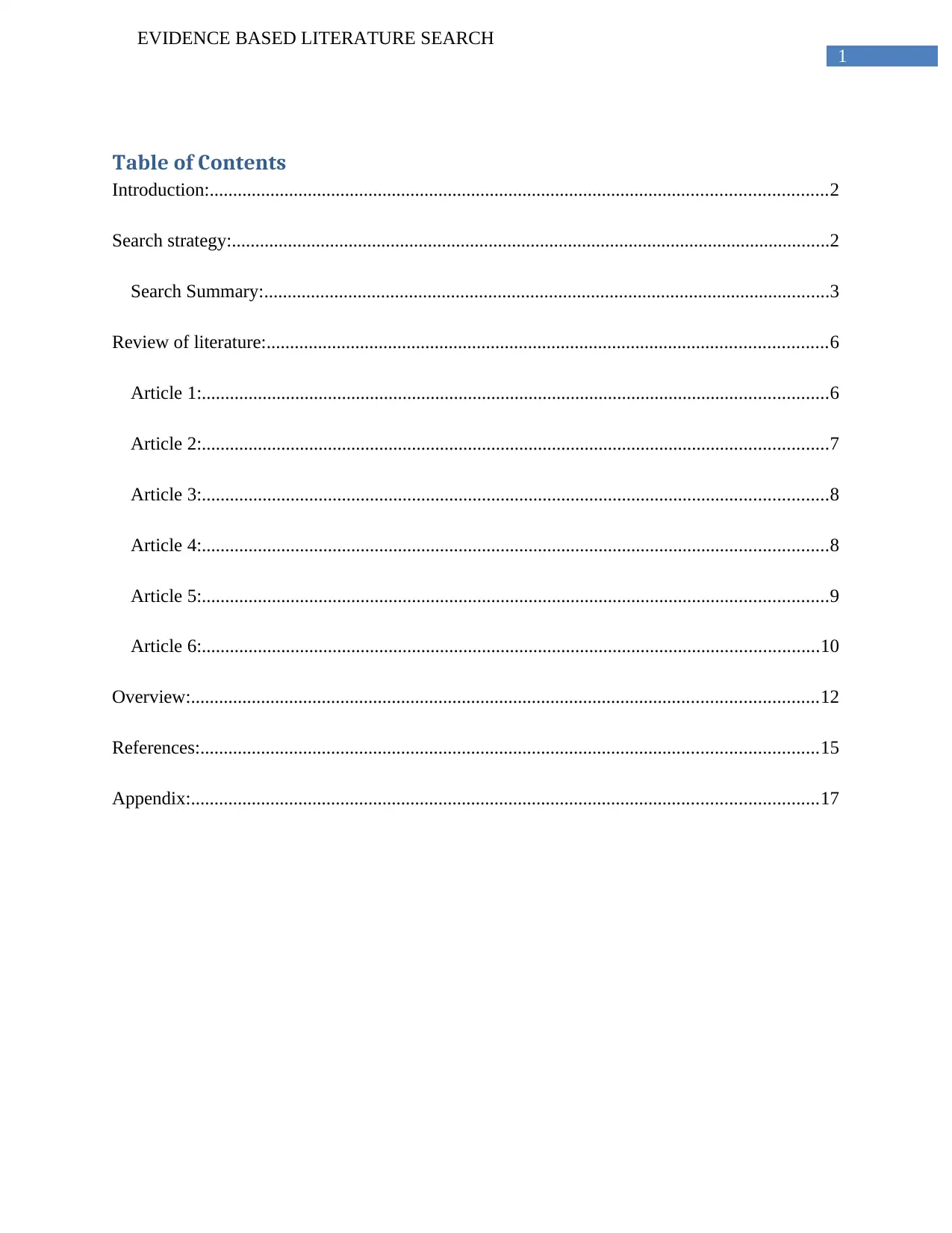
1
EVIDENCE BASED LITERATURE SEARCH
Table of Contents
Introduction:....................................................................................................................................2
Search strategy:................................................................................................................................2
Search Summary:.........................................................................................................................3
Review of literature:........................................................................................................................6
Article 1:......................................................................................................................................6
Article 2:......................................................................................................................................7
Article 3:......................................................................................................................................8
Article 4:......................................................................................................................................8
Article 5:......................................................................................................................................9
Article 6:....................................................................................................................................10
Overview:......................................................................................................................................12
References:....................................................................................................................................15
Appendix:......................................................................................................................................17
EVIDENCE BASED LITERATURE SEARCH
Table of Contents
Introduction:....................................................................................................................................2
Search strategy:................................................................................................................................2
Search Summary:.........................................................................................................................3
Review of literature:........................................................................................................................6
Article 1:......................................................................................................................................6
Article 2:......................................................................................................................................7
Article 3:......................................................................................................................................8
Article 4:......................................................................................................................................8
Article 5:......................................................................................................................................9
Article 6:....................................................................................................................................10
Overview:......................................................................................................................................12
References:....................................................................................................................................15
Appendix:......................................................................................................................................17
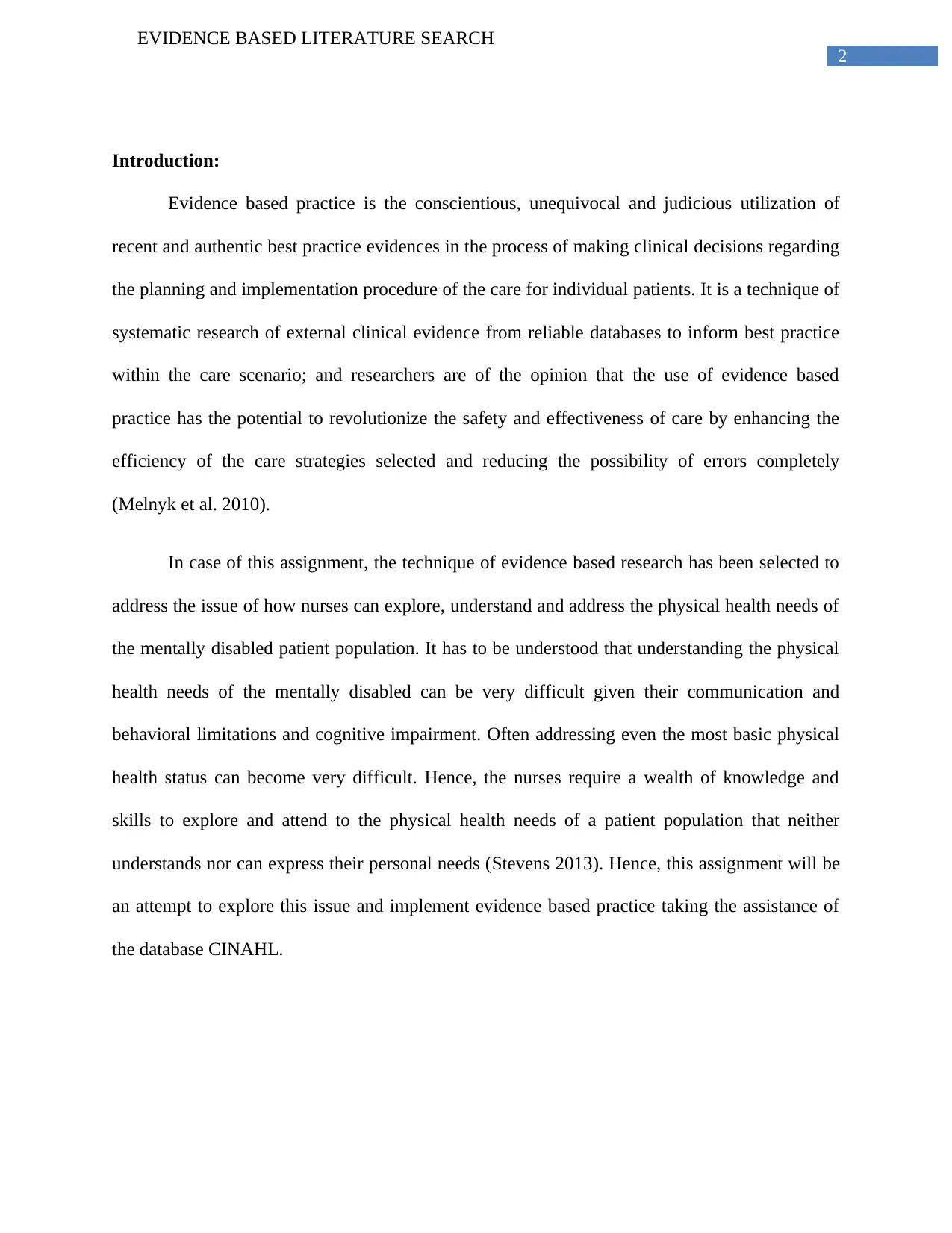
2
EVIDENCE BASED LITERATURE SEARCH
Introduction:
Evidence based practice is the conscientious, unequivocal and judicious utilization of
recent and authentic best practice evidences in the process of making clinical decisions regarding
the planning and implementation procedure of the care for individual patients. It is a technique of
systematic research of external clinical evidence from reliable databases to inform best practice
within the care scenario; and researchers are of the opinion that the use of evidence based
practice has the potential to revolutionize the safety and effectiveness of care by enhancing the
efficiency of the care strategies selected and reducing the possibility of errors completely
(Melnyk et al. 2010).
In case of this assignment, the technique of evidence based research has been selected to
address the issue of how nurses can explore, understand and address the physical health needs of
the mentally disabled patient population. It has to be understood that understanding the physical
health needs of the mentally disabled can be very difficult given their communication and
behavioral limitations and cognitive impairment. Often addressing even the most basic physical
health status can become very difficult. Hence, the nurses require a wealth of knowledge and
skills to explore and attend to the physical health needs of a patient population that neither
understands nor can express their personal needs (Stevens 2013). Hence, this assignment will be
an attempt to explore this issue and implement evidence based practice taking the assistance of
the database CINAHL.
EVIDENCE BASED LITERATURE SEARCH
Introduction:
Evidence based practice is the conscientious, unequivocal and judicious utilization of
recent and authentic best practice evidences in the process of making clinical decisions regarding
the planning and implementation procedure of the care for individual patients. It is a technique of
systematic research of external clinical evidence from reliable databases to inform best practice
within the care scenario; and researchers are of the opinion that the use of evidence based
practice has the potential to revolutionize the safety and effectiveness of care by enhancing the
efficiency of the care strategies selected and reducing the possibility of errors completely
(Melnyk et al. 2010).
In case of this assignment, the technique of evidence based research has been selected to
address the issue of how nurses can explore, understand and address the physical health needs of
the mentally disabled patient population. It has to be understood that understanding the physical
health needs of the mentally disabled can be very difficult given their communication and
behavioral limitations and cognitive impairment. Often addressing even the most basic physical
health status can become very difficult. Hence, the nurses require a wealth of knowledge and
skills to explore and attend to the physical health needs of a patient population that neither
understands nor can express their personal needs (Stevens 2013). Hence, this assignment will be
an attempt to explore this issue and implement evidence based practice taking the assistance of
the database CINAHL.
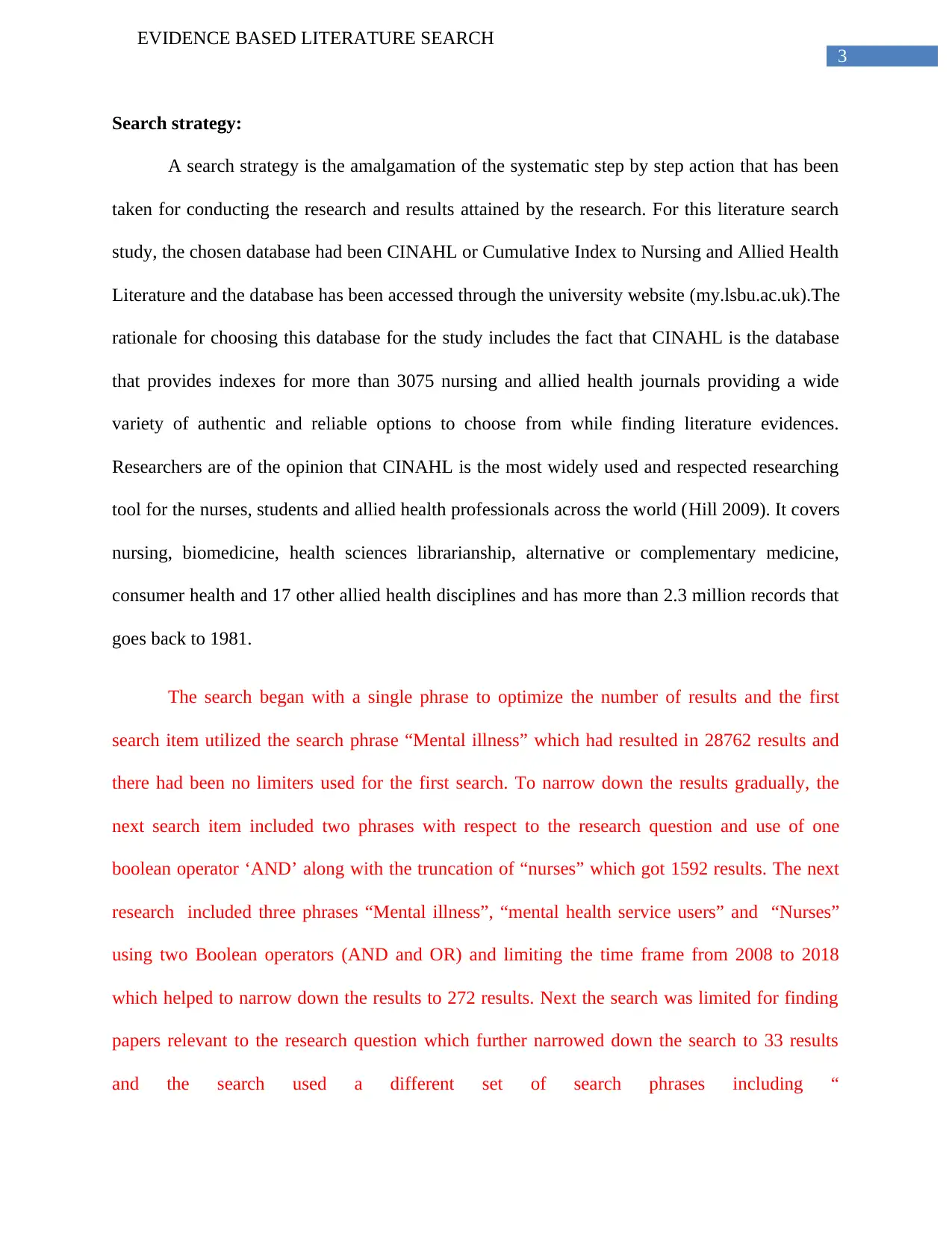
3
EVIDENCE BASED LITERATURE SEARCH
Search strategy:
A search strategy is the amalgamation of the systematic step by step action that has been
taken for conducting the research and results attained by the research. For this literature search
study, the chosen database had been CINAHL or Cumulative Index to Nursing and Allied Health
Literature and the database has been accessed through the university website (my.lsbu.ac.uk).The
rationale for choosing this database for the study includes the fact that CINAHL is the database
that provides indexes for more than 3075 nursing and allied health journals providing a wide
variety of authentic and reliable options to choose from while finding literature evidences.
Researchers are of the opinion that CINAHL is the most widely used and respected researching
tool for the nurses, students and allied health professionals across the world (Hill 2009). It covers
nursing, biomedicine, health sciences librarianship, alternative or complementary medicine,
consumer health and 17 other allied health disciplines and has more than 2.3 million records that
goes back to 1981.
The search began with a single phrase to optimize the number of results and the first
search item utilized the search phrase “Mental illness” which had resulted in 28762 results and
there had been no limiters used for the first search. To narrow down the results gradually, the
next search item included two phrases with respect to the research question and use of one
boolean operator ‘AND’ along with the truncation of “nurses” which got 1592 results. The next
research included three phrases “Mental illness”, “mental health service users” and “Nurses”
using two Boolean operators (AND and OR) and limiting the time frame from 2008 to 2018
which helped to narrow down the results to 272 results. Next the search was limited for finding
papers relevant to the research question which further narrowed down the search to 33 results
and the search used a different set of search phrases including “
EVIDENCE BASED LITERATURE SEARCH
Search strategy:
A search strategy is the amalgamation of the systematic step by step action that has been
taken for conducting the research and results attained by the research. For this literature search
study, the chosen database had been CINAHL or Cumulative Index to Nursing and Allied Health
Literature and the database has been accessed through the university website (my.lsbu.ac.uk).The
rationale for choosing this database for the study includes the fact that CINAHL is the database
that provides indexes for more than 3075 nursing and allied health journals providing a wide
variety of authentic and reliable options to choose from while finding literature evidences.
Researchers are of the opinion that CINAHL is the most widely used and respected researching
tool for the nurses, students and allied health professionals across the world (Hill 2009). It covers
nursing, biomedicine, health sciences librarianship, alternative or complementary medicine,
consumer health and 17 other allied health disciplines and has more than 2.3 million records that
goes back to 1981.
The search began with a single phrase to optimize the number of results and the first
search item utilized the search phrase “Mental illness” which had resulted in 28762 results and
there had been no limiters used for the first search. To narrow down the results gradually, the
next search item included two phrases with respect to the research question and use of one
boolean operator ‘AND’ along with the truncation of “nurses” which got 1592 results. The next
research included three phrases “Mental illness”, “mental health service users” and “Nurses”
using two Boolean operators (AND and OR) and limiting the time frame from 2008 to 2018
which helped to narrow down the results to 272 results. Next the search was limited for finding
papers relevant to the research question which further narrowed down the search to 33 results
and the search used a different set of search phrases including “
Secure Best Marks with AI Grader
Need help grading? Try our AI Grader for instant feedback on your assignments.
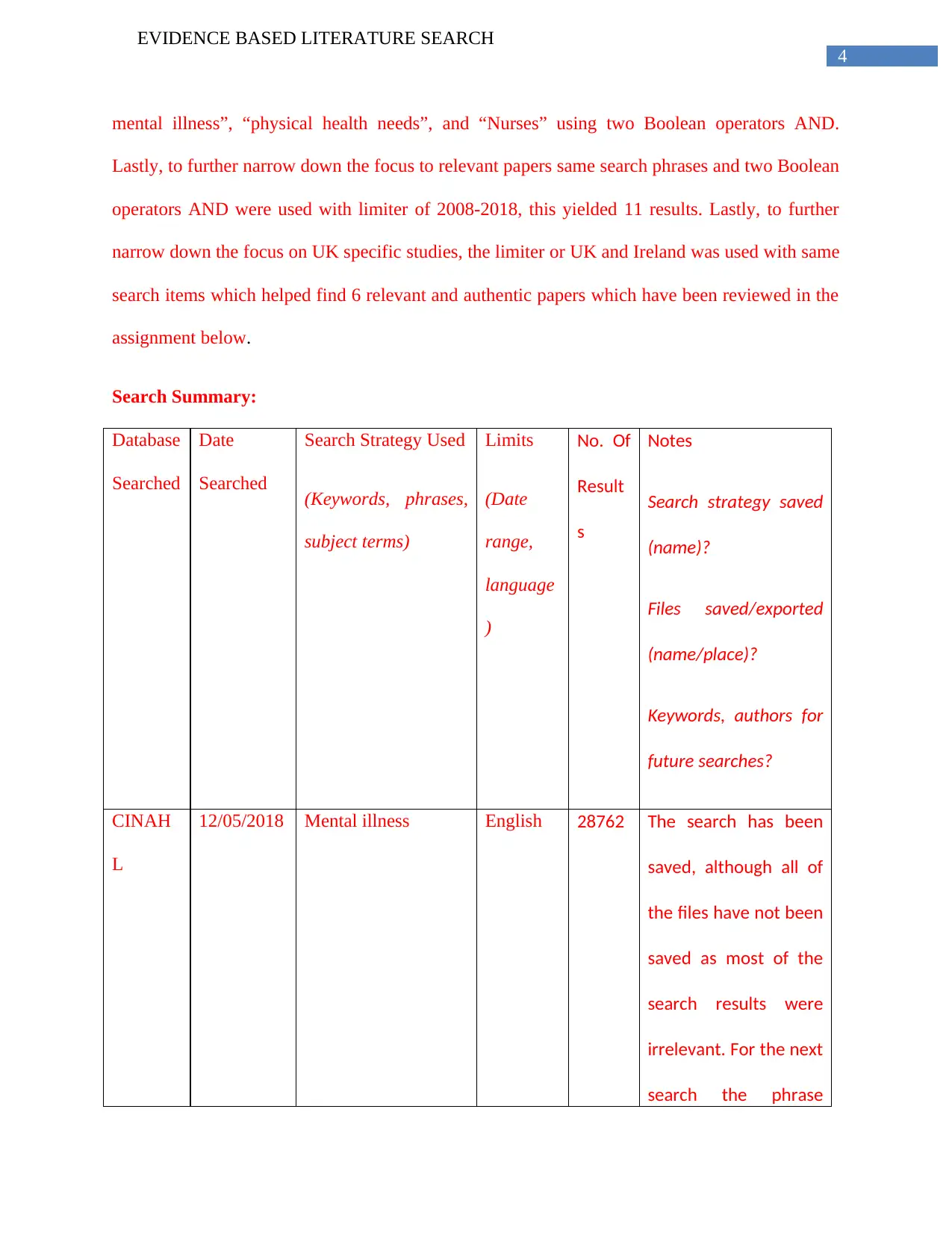
4
EVIDENCE BASED LITERATURE SEARCH
mental illness”, “physical health needs”, and “Nurses” using two Boolean operators AND.
Lastly, to further narrow down the focus to relevant papers same search phrases and two Boolean
operators AND were used with limiter of 2008-2018, this yielded 11 results. Lastly, to further
narrow down the focus on UK specific studies, the limiter or UK and Ireland was used with same
search items which helped find 6 relevant and authentic papers which have been reviewed in the
assignment below.
Search Summary:
Database
Searched
Date
Searched
Search Strategy Used
(Keywords, phrases,
subject terms)
Limits
(Date
range,
language
)
No. Of
Result
s
Notes
Search strategy saved
(name)?
Files saved/exported
(name/place)?
Keywords, authors for
future searches?
CINAH
L
12/05/2018 Mental illness English 28762 The search has been
saved, although all of
the files have not been
saved as most of the
search results were
irrelevant. For the next
search the phrase
EVIDENCE BASED LITERATURE SEARCH
mental illness”, “physical health needs”, and “Nurses” using two Boolean operators AND.
Lastly, to further narrow down the focus to relevant papers same search phrases and two Boolean
operators AND were used with limiter of 2008-2018, this yielded 11 results. Lastly, to further
narrow down the focus on UK specific studies, the limiter or UK and Ireland was used with same
search items which helped find 6 relevant and authentic papers which have been reviewed in the
assignment below.
Search Summary:
Database
Searched
Date
Searched
Search Strategy Used
(Keywords, phrases,
subject terms)
Limits
(Date
range,
language
)
No. Of
Result
s
Notes
Search strategy saved
(name)?
Files saved/exported
(name/place)?
Keywords, authors for
future searches?
CINAH
L
12/05/2018 Mental illness English 28762 The search has been
saved, although all of
the files have not been
saved as most of the
search results were
irrelevant. For the next
search the phrase
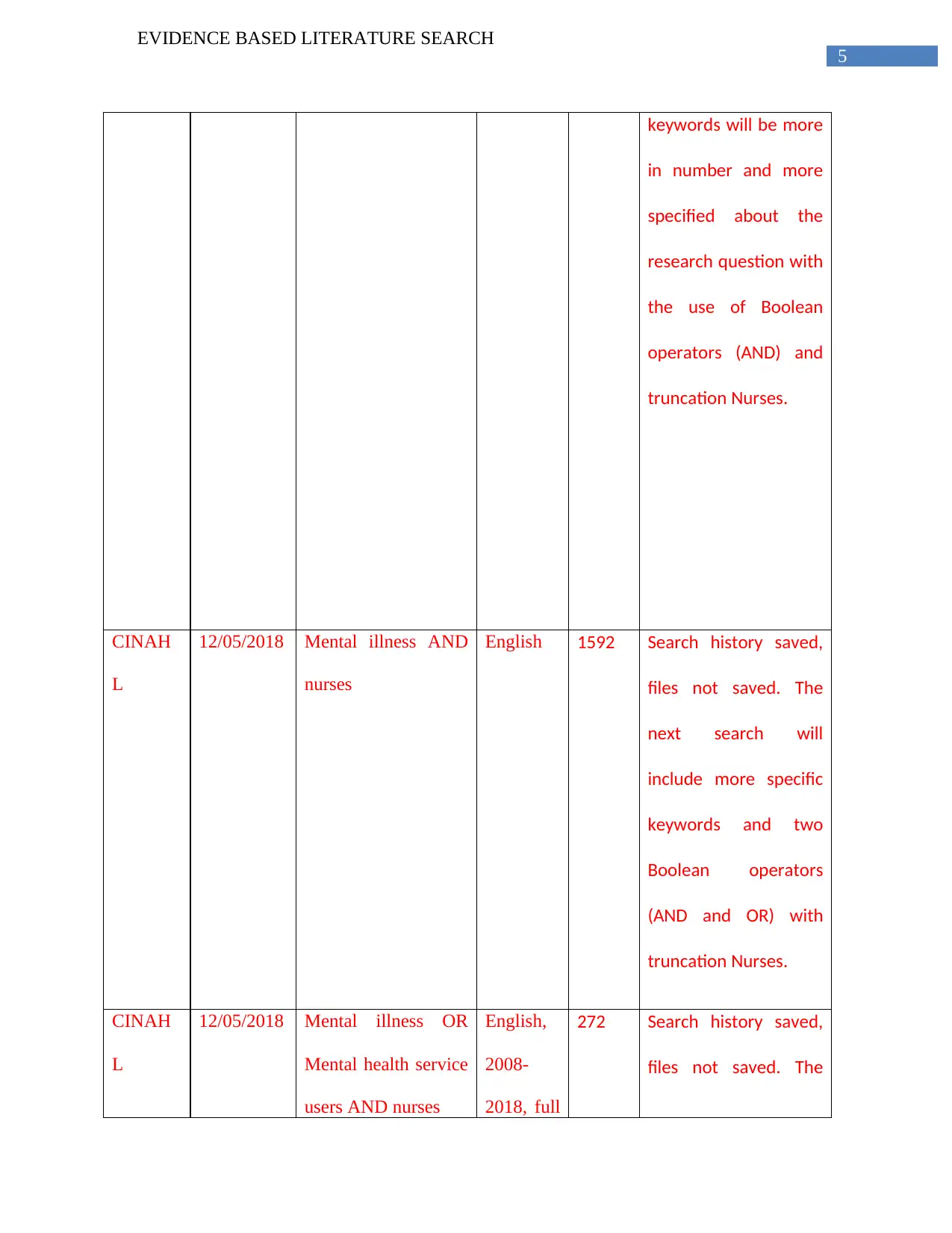
5
EVIDENCE BASED LITERATURE SEARCH
keywords will be more
in number and more
specified about the
research question with
the use of Boolean
operators (AND) and
truncation Nurses.
CINAH
L
12/05/2018 Mental illness AND
nurses
English 1592 Search history saved,
files not saved. The
next search will
include more specific
keywords and two
Boolean operators
(AND and OR) with
truncation Nurses.
CINAH
L
12/05/2018 Mental illness OR
Mental health service
users AND nurses
English,
2008-
2018, full
272 Search history saved,
files not saved. The
EVIDENCE BASED LITERATURE SEARCH
keywords will be more
in number and more
specified about the
research question with
the use of Boolean
operators (AND) and
truncation Nurses.
CINAH
L
12/05/2018 Mental illness AND
nurses
English 1592 Search history saved,
files not saved. The
next search will
include more specific
keywords and two
Boolean operators
(AND and OR) with
truncation Nurses.
CINAH
L
12/05/2018 Mental illness OR
Mental health service
users AND nurses
English,
2008-
2018, full
272 Search history saved,
files not saved. The
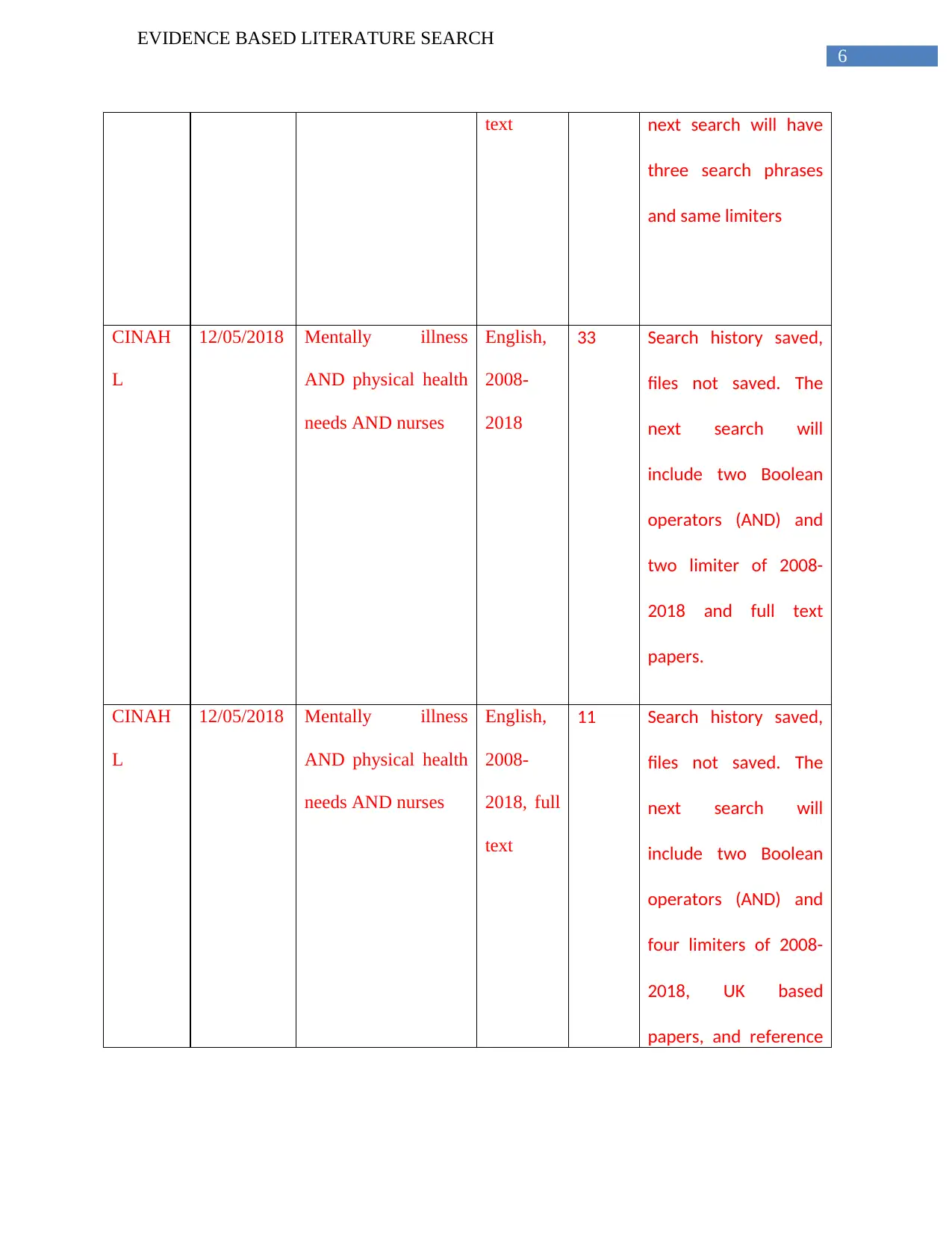
6
EVIDENCE BASED LITERATURE SEARCH
text next search will have
three search phrases
and same limiters
CINAH
L
12/05/2018 Mentally illness
AND physical health
needs AND nurses
English,
2008-
2018
33 Search history saved,
files not saved. The
next search will
include two Boolean
operators (AND) and
two limiter of 2008-
2018 and full text
papers.
CINAH
L
12/05/2018 Mentally illness
AND physical health
needs AND nurses
English,
2008-
2018, full
text
11 Search history saved,
files not saved. The
next search will
include two Boolean
operators (AND) and
four limiters of 2008-
2018, UK based
papers, and reference
EVIDENCE BASED LITERATURE SEARCH
text next search will have
three search phrases
and same limiters
CINAH
L
12/05/2018 Mentally illness
AND physical health
needs AND nurses
English,
2008-
2018
33 Search history saved,
files not saved. The
next search will
include two Boolean
operators (AND) and
two limiter of 2008-
2018 and full text
papers.
CINAH
L
12/05/2018 Mentally illness
AND physical health
needs AND nurses
English,
2008-
2018, full
text
11 Search history saved,
files not saved. The
next search will
include two Boolean
operators (AND) and
four limiters of 2008-
2018, UK based
papers, and reference
Paraphrase This Document
Need a fresh take? Get an instant paraphrase of this document with our AI Paraphraser
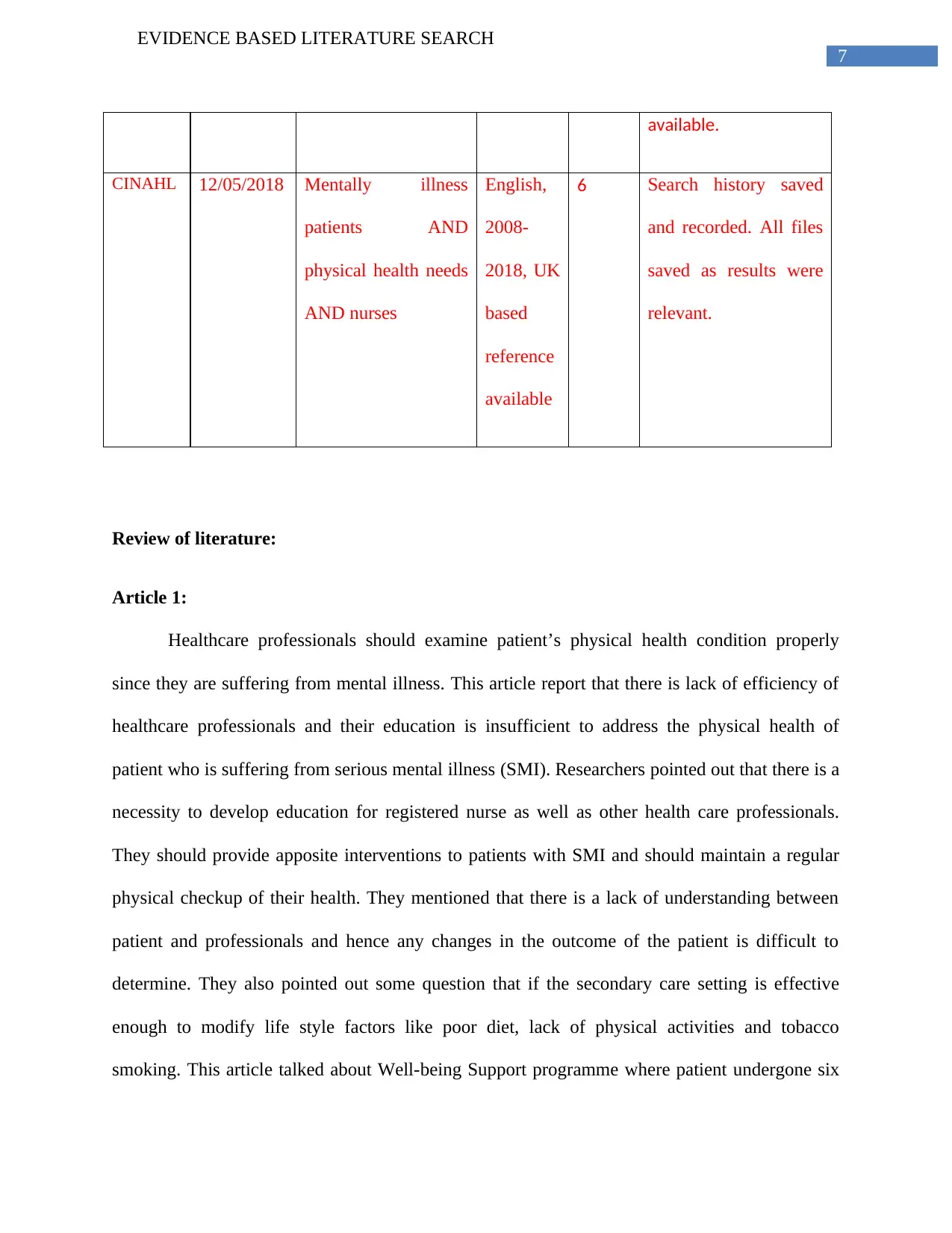
7
EVIDENCE BASED LITERATURE SEARCH
available.
CINAHL 12/05/2018 Mentally illness
patients AND
physical health needs
AND nurses
English,
2008-
2018, UK
based
reference
available
6 Search history saved
and recorded. All files
saved as results were
relevant.
Review of literature:
Article 1:
Healthcare professionals should examine patient’s physical health condition properly
since they are suffering from mental illness. This article report that there is lack of efficiency of
healthcare professionals and their education is insufficient to address the physical health of
patient who is suffering from serious mental illness (SMI). Researchers pointed out that there is a
necessity to develop education for registered nurse as well as other health care professionals.
They should provide apposite interventions to patients with SMI and should maintain a regular
physical checkup of their health. They mentioned that there is a lack of understanding between
patient and professionals and hence any changes in the outcome of the patient is difficult to
determine. They also pointed out some question that if the secondary care setting is effective
enough to modify life style factors like poor diet, lack of physical activities and tobacco
smoking. This article talked about Well-being Support programme where patient undergone six
EVIDENCE BASED LITERATURE SEARCH
available.
CINAHL 12/05/2018 Mentally illness
patients AND
physical health needs
AND nurses
English,
2008-
2018, UK
based
reference
available
6 Search history saved
and recorded. All files
saved as results were
relevant.
Review of literature:
Article 1:
Healthcare professionals should examine patient’s physical health condition properly
since they are suffering from mental illness. This article report that there is lack of efficiency of
healthcare professionals and their education is insufficient to address the physical health of
patient who is suffering from serious mental illness (SMI). Researchers pointed out that there is a
necessity to develop education for registered nurse as well as other health care professionals.
They should provide apposite interventions to patients with SMI and should maintain a regular
physical checkup of their health. They mentioned that there is a lack of understanding between
patient and professionals and hence any changes in the outcome of the patient is difficult to
determine. They also pointed out some question that if the secondary care setting is effective
enough to modify life style factors like poor diet, lack of physical activities and tobacco
smoking. This article talked about Well-being Support programme where patient undergone six
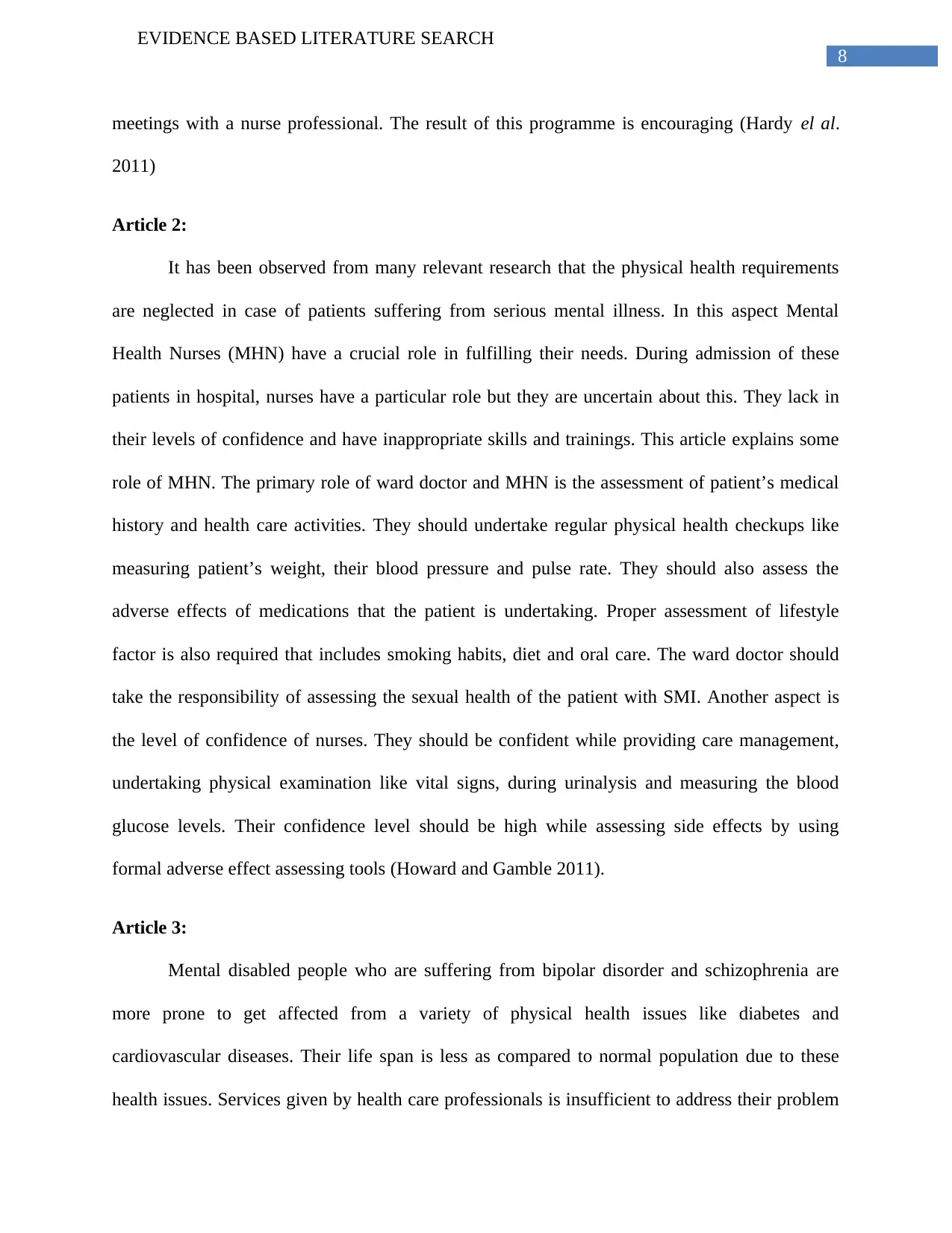
8
EVIDENCE BASED LITERATURE SEARCH
meetings with a nurse professional. The result of this programme is encouraging (Hardy el al.
2011)
Article 2:
It has been observed from many relevant research that the physical health requirements
are neglected in case of patients suffering from serious mental illness. In this aspect Mental
Health Nurses (MHN) have a crucial role in fulfilling their needs. During admission of these
patients in hospital, nurses have a particular role but they are uncertain about this. They lack in
their levels of confidence and have inappropriate skills and trainings. This article explains some
role of MHN. The primary role of ward doctor and MHN is the assessment of patient’s medical
history and health care activities. They should undertake regular physical health checkups like
measuring patient’s weight, their blood pressure and pulse rate. They should also assess the
adverse effects of medications that the patient is undertaking. Proper assessment of lifestyle
factor is also required that includes smoking habits, diet and oral care. The ward doctor should
take the responsibility of assessing the sexual health of the patient with SMI. Another aspect is
the level of confidence of nurses. They should be confident while providing care management,
undertaking physical examination like vital signs, during urinalysis and measuring the blood
glucose levels. Their confidence level should be high while assessing side effects by using
formal adverse effect assessing tools (Howard and Gamble 2011).
Article 3:
Mental disabled people who are suffering from bipolar disorder and schizophrenia are
more prone to get affected from a variety of physical health issues like diabetes and
cardiovascular diseases. Their life span is less as compared to normal population due to these
health issues. Services given by health care professionals is insufficient to address their problem
EVIDENCE BASED LITERATURE SEARCH
meetings with a nurse professional. The result of this programme is encouraging (Hardy el al.
2011)
Article 2:
It has been observed from many relevant research that the physical health requirements
are neglected in case of patients suffering from serious mental illness. In this aspect Mental
Health Nurses (MHN) have a crucial role in fulfilling their needs. During admission of these
patients in hospital, nurses have a particular role but they are uncertain about this. They lack in
their levels of confidence and have inappropriate skills and trainings. This article explains some
role of MHN. The primary role of ward doctor and MHN is the assessment of patient’s medical
history and health care activities. They should undertake regular physical health checkups like
measuring patient’s weight, their blood pressure and pulse rate. They should also assess the
adverse effects of medications that the patient is undertaking. Proper assessment of lifestyle
factor is also required that includes smoking habits, diet and oral care. The ward doctor should
take the responsibility of assessing the sexual health of the patient with SMI. Another aspect is
the level of confidence of nurses. They should be confident while providing care management,
undertaking physical examination like vital signs, during urinalysis and measuring the blood
glucose levels. Their confidence level should be high while assessing side effects by using
formal adverse effect assessing tools (Howard and Gamble 2011).
Article 3:
Mental disabled people who are suffering from bipolar disorder and schizophrenia are
more prone to get affected from a variety of physical health issues like diabetes and
cardiovascular diseases. Their life span is less as compared to normal population due to these
health issues. Services given by health care professionals is insufficient to address their problem
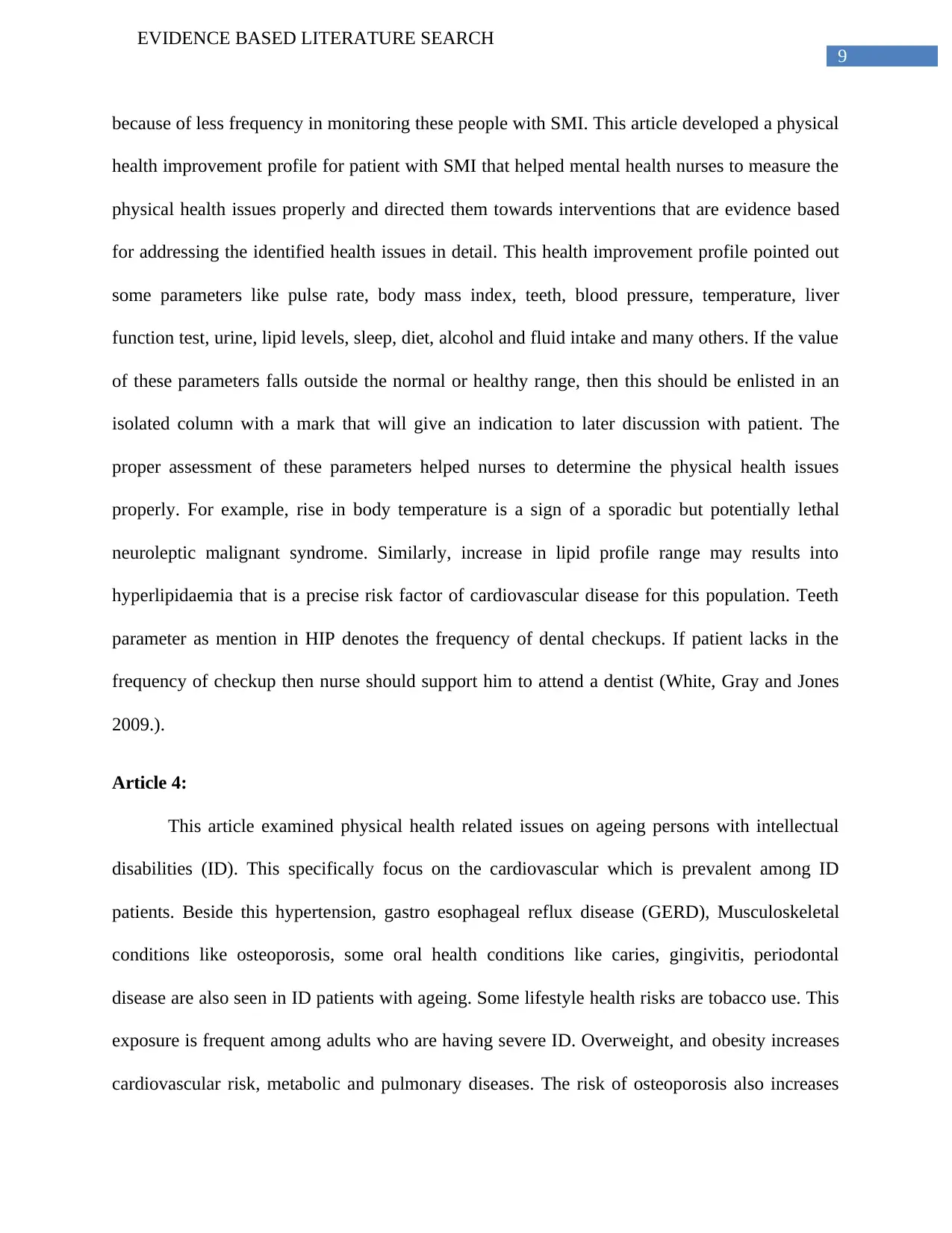
9
EVIDENCE BASED LITERATURE SEARCH
because of less frequency in monitoring these people with SMI. This article developed a physical
health improvement profile for patient with SMI that helped mental health nurses to measure the
physical health issues properly and directed them towards interventions that are evidence based
for addressing the identified health issues in detail. This health improvement profile pointed out
some parameters like pulse rate, body mass index, teeth, blood pressure, temperature, liver
function test, urine, lipid levels, sleep, diet, alcohol and fluid intake and many others. If the value
of these parameters falls outside the normal or healthy range, then this should be enlisted in an
isolated column with a mark that will give an indication to later discussion with patient. The
proper assessment of these parameters helped nurses to determine the physical health issues
properly. For example, rise in body temperature is a sign of a sporadic but potentially lethal
neuroleptic malignant syndrome. Similarly, increase in lipid profile range may results into
hyperlipidaemia that is a precise risk factor of cardiovascular disease for this population. Teeth
parameter as mention in HIP denotes the frequency of dental checkups. If patient lacks in the
frequency of checkup then nurse should support him to attend a dentist (White, Gray and Jones
2009.).
Article 4:
This article examined physical health related issues on ageing persons with intellectual
disabilities (ID). This specifically focus on the cardiovascular which is prevalent among ID
patients. Beside this hypertension, gastro esophageal reflux disease (GERD), Musculoskeletal
conditions like osteoporosis, some oral health conditions like caries, gingivitis, periodontal
disease are also seen in ID patients with ageing. Some lifestyle health risks are tobacco use. This
exposure is frequent among adults who are having severe ID. Overweight, and obesity increases
cardiovascular risk, metabolic and pulmonary diseases. The risk of osteoporosis also increases
EVIDENCE BASED LITERATURE SEARCH
because of less frequency in monitoring these people with SMI. This article developed a physical
health improvement profile for patient with SMI that helped mental health nurses to measure the
physical health issues properly and directed them towards interventions that are evidence based
for addressing the identified health issues in detail. This health improvement profile pointed out
some parameters like pulse rate, body mass index, teeth, blood pressure, temperature, liver
function test, urine, lipid levels, sleep, diet, alcohol and fluid intake and many others. If the value
of these parameters falls outside the normal or healthy range, then this should be enlisted in an
isolated column with a mark that will give an indication to later discussion with patient. The
proper assessment of these parameters helped nurses to determine the physical health issues
properly. For example, rise in body temperature is a sign of a sporadic but potentially lethal
neuroleptic malignant syndrome. Similarly, increase in lipid profile range may results into
hyperlipidaemia that is a precise risk factor of cardiovascular disease for this population. Teeth
parameter as mention in HIP denotes the frequency of dental checkups. If patient lacks in the
frequency of checkup then nurse should support him to attend a dentist (White, Gray and Jones
2009.).
Article 4:
This article examined physical health related issues on ageing persons with intellectual
disabilities (ID). This specifically focus on the cardiovascular which is prevalent among ID
patients. Beside this hypertension, gastro esophageal reflux disease (GERD), Musculoskeletal
conditions like osteoporosis, some oral health conditions like caries, gingivitis, periodontal
disease are also seen in ID patients with ageing. Some lifestyle health risks are tobacco use. This
exposure is frequent among adults who are having severe ID. Overweight, and obesity increases
cardiovascular risk, metabolic and pulmonary diseases. The risk of osteoporosis also increases
Secure Best Marks with AI Grader
Need help grading? Try our AI Grader for instant feedback on your assignments.
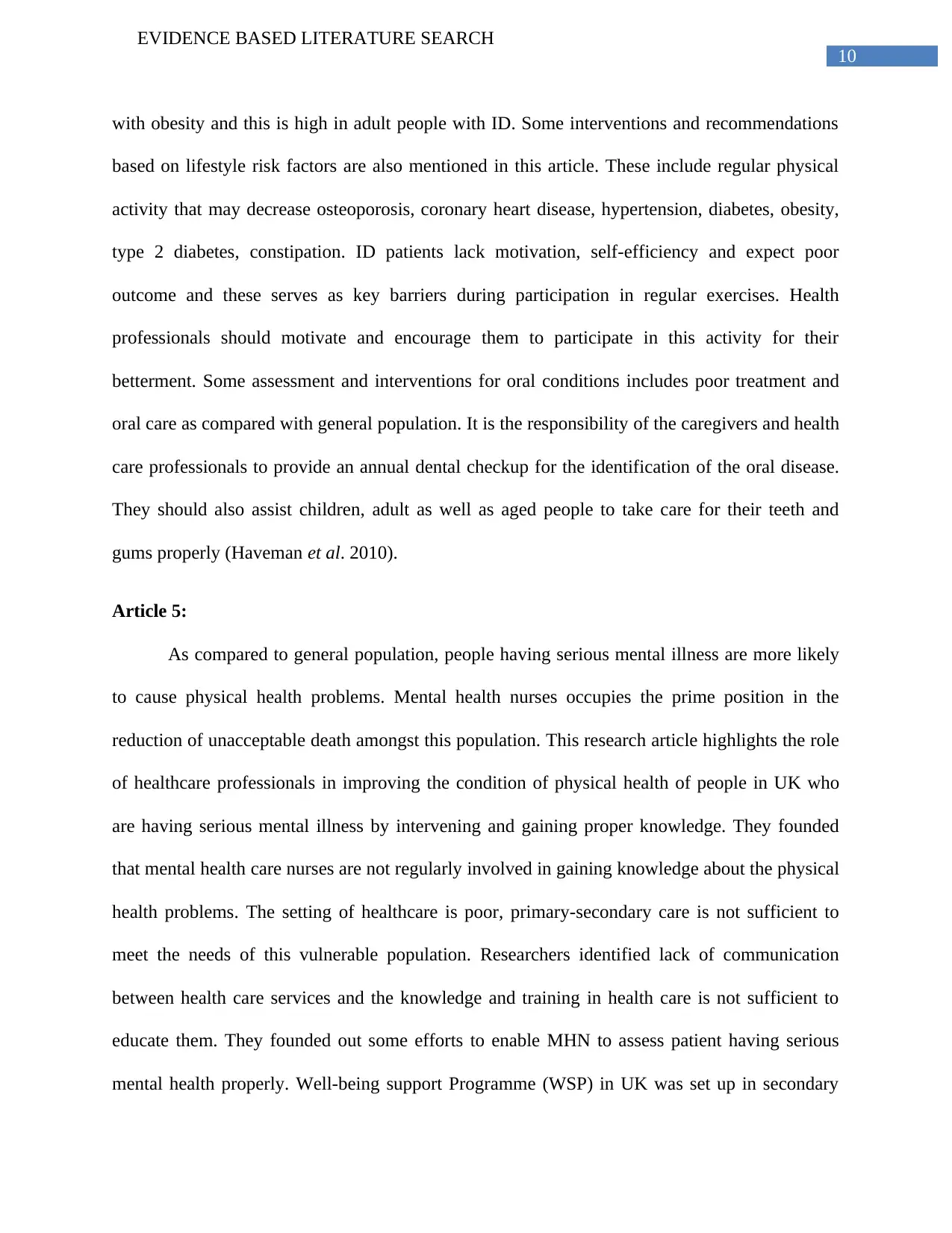
10
EVIDENCE BASED LITERATURE SEARCH
with obesity and this is high in adult people with ID. Some interventions and recommendations
based on lifestyle risk factors are also mentioned in this article. These include regular physical
activity that may decrease osteoporosis, coronary heart disease, hypertension, diabetes, obesity,
type 2 diabetes, constipation. ID patients lack motivation, self-efficiency and expect poor
outcome and these serves as key barriers during participation in regular exercises. Health
professionals should motivate and encourage them to participate in this activity for their
betterment. Some assessment and interventions for oral conditions includes poor treatment and
oral care as compared with general population. It is the responsibility of the caregivers and health
care professionals to provide an annual dental checkup for the identification of the oral disease.
They should also assist children, adult as well as aged people to take care for their teeth and
gums properly (Haveman et al. 2010).
Article 5:
As compared to general population, people having serious mental illness are more likely
to cause physical health problems. Mental health nurses occupies the prime position in the
reduction of unacceptable death amongst this population. This research article highlights the role
of healthcare professionals in improving the condition of physical health of people in UK who
are having serious mental illness by intervening and gaining proper knowledge. They founded
that mental health care nurses are not regularly involved in gaining knowledge about the physical
health problems. The setting of healthcare is poor, primary-secondary care is not sufficient to
meet the needs of this vulnerable population. Researchers identified lack of communication
between health care services and the knowledge and training in health care is not sufficient to
educate them. They founded out some efforts to enable MHN to assess patient having serious
mental health properly. Well-being support Programme (WSP) in UK was set up in secondary
EVIDENCE BASED LITERATURE SEARCH
with obesity and this is high in adult people with ID. Some interventions and recommendations
based on lifestyle risk factors are also mentioned in this article. These include regular physical
activity that may decrease osteoporosis, coronary heart disease, hypertension, diabetes, obesity,
type 2 diabetes, constipation. ID patients lack motivation, self-efficiency and expect poor
outcome and these serves as key barriers during participation in regular exercises. Health
professionals should motivate and encourage them to participate in this activity for their
betterment. Some assessment and interventions for oral conditions includes poor treatment and
oral care as compared with general population. It is the responsibility of the caregivers and health
care professionals to provide an annual dental checkup for the identification of the oral disease.
They should also assist children, adult as well as aged people to take care for their teeth and
gums properly (Haveman et al. 2010).
Article 5:
As compared to general population, people having serious mental illness are more likely
to cause physical health problems. Mental health nurses occupies the prime position in the
reduction of unacceptable death amongst this population. This research article highlights the role
of healthcare professionals in improving the condition of physical health of people in UK who
are having serious mental illness by intervening and gaining proper knowledge. They founded
that mental health care nurses are not regularly involved in gaining knowledge about the physical
health problems. The setting of healthcare is poor, primary-secondary care is not sufficient to
meet the needs of this vulnerable population. Researchers identified lack of communication
between health care services and the knowledge and training in health care is not sufficient to
educate them. They founded out some efforts to enable MHN to assess patient having serious
mental health properly. Well-being support Programme (WSP) in UK was set up in secondary
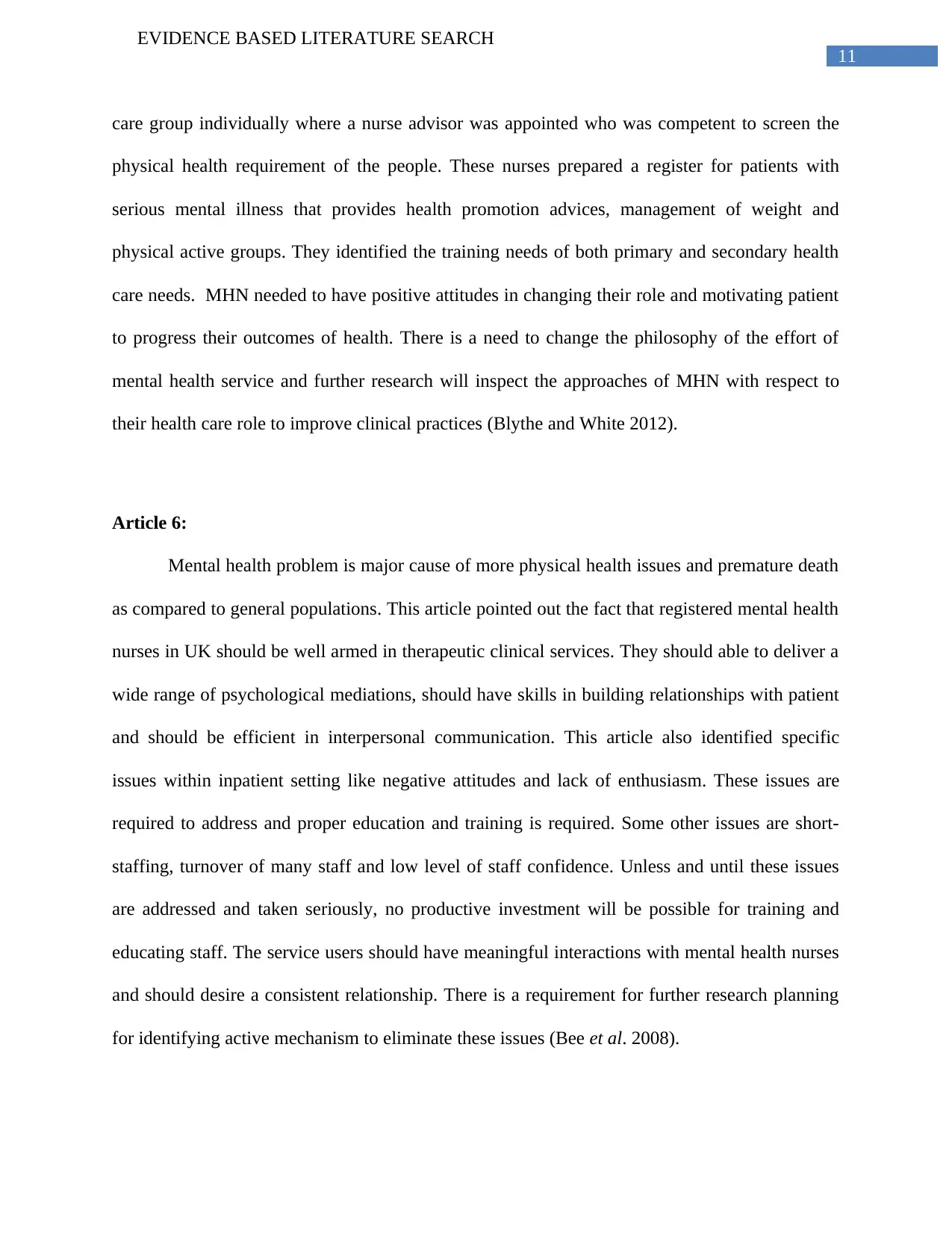
11
EVIDENCE BASED LITERATURE SEARCH
care group individually where a nurse advisor was appointed who was competent to screen the
physical health requirement of the people. These nurses prepared a register for patients with
serious mental illness that provides health promotion advices, management of weight and
physical active groups. They identified the training needs of both primary and secondary health
care needs. MHN needed to have positive attitudes in changing their role and motivating patient
to progress their outcomes of health. There is a need to change the philosophy of the effort of
mental health service and further research will inspect the approaches of MHN with respect to
their health care role to improve clinical practices (Blythe and White 2012).
Article 6:
Mental health problem is major cause of more physical health issues and premature death
as compared to general populations. This article pointed out the fact that registered mental health
nurses in UK should be well armed in therapeutic clinical services. They should able to deliver a
wide range of psychological mediations, should have skills in building relationships with patient
and should be efficient in interpersonal communication. This article also identified specific
issues within inpatient setting like negative attitudes and lack of enthusiasm. These issues are
required to address and proper education and training is required. Some other issues are short-
staffing, turnover of many staff and low level of staff confidence. Unless and until these issues
are addressed and taken seriously, no productive investment will be possible for training and
educating staff. The service users should have meaningful interactions with mental health nurses
and should desire a consistent relationship. There is a requirement for further research planning
for identifying active mechanism to eliminate these issues (Bee et al. 2008).
EVIDENCE BASED LITERATURE SEARCH
care group individually where a nurse advisor was appointed who was competent to screen the
physical health requirement of the people. These nurses prepared a register for patients with
serious mental illness that provides health promotion advices, management of weight and
physical active groups. They identified the training needs of both primary and secondary health
care needs. MHN needed to have positive attitudes in changing their role and motivating patient
to progress their outcomes of health. There is a need to change the philosophy of the effort of
mental health service and further research will inspect the approaches of MHN with respect to
their health care role to improve clinical practices (Blythe and White 2012).
Article 6:
Mental health problem is major cause of more physical health issues and premature death
as compared to general populations. This article pointed out the fact that registered mental health
nurses in UK should be well armed in therapeutic clinical services. They should able to deliver a
wide range of psychological mediations, should have skills in building relationships with patient
and should be efficient in interpersonal communication. This article also identified specific
issues within inpatient setting like negative attitudes and lack of enthusiasm. These issues are
required to address and proper education and training is required. Some other issues are short-
staffing, turnover of many staff and low level of staff confidence. Unless and until these issues
are addressed and taken seriously, no productive investment will be possible for training and
educating staff. The service users should have meaningful interactions with mental health nurses
and should desire a consistent relationship. There is a requirement for further research planning
for identifying active mechanism to eliminate these issues (Bee et al. 2008).
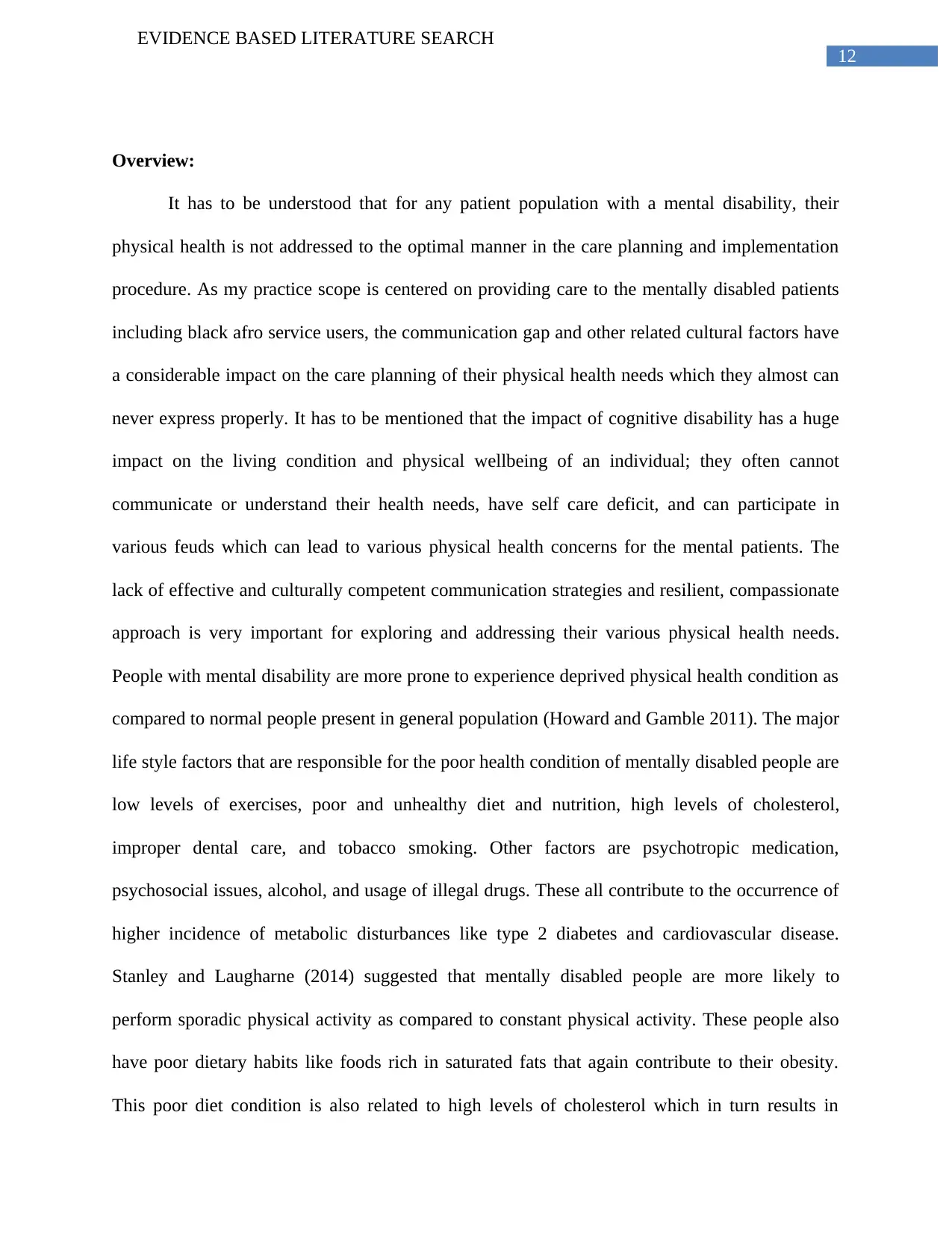
12
EVIDENCE BASED LITERATURE SEARCH
Overview:
It has to be understood that for any patient population with a mental disability, their
physical health is not addressed to the optimal manner in the care planning and implementation
procedure. As my practice scope is centered on providing care to the mentally disabled patients
including black afro service users, the communication gap and other related cultural factors have
a considerable impact on the care planning of their physical health needs which they almost can
never express properly. It has to be mentioned that the impact of cognitive disability has a huge
impact on the living condition and physical wellbeing of an individual; they often cannot
communicate or understand their health needs, have self care deficit, and can participate in
various feuds which can lead to various physical health concerns for the mental patients. The
lack of effective and culturally competent communication strategies and resilient, compassionate
approach is very important for exploring and addressing their various physical health needs.
People with mental disability are more prone to experience deprived physical health condition as
compared to normal people present in general population (Howard and Gamble 2011). The major
life style factors that are responsible for the poor health condition of mentally disabled people are
low levels of exercises, poor and unhealthy diet and nutrition, high levels of cholesterol,
improper dental care, and tobacco smoking. Other factors are psychotropic medication,
psychosocial issues, alcohol, and usage of illegal drugs. These all contribute to the occurrence of
higher incidence of metabolic disturbances like type 2 diabetes and cardiovascular disease.
Stanley and Laugharne (2014) suggested that mentally disabled people are more likely to
perform sporadic physical activity as compared to constant physical activity. These people also
have poor dietary habits like foods rich in saturated fats that again contribute to their obesity.
This poor diet condition is also related to high levels of cholesterol which in turn results in
EVIDENCE BASED LITERATURE SEARCH
Overview:
It has to be understood that for any patient population with a mental disability, their
physical health is not addressed to the optimal manner in the care planning and implementation
procedure. As my practice scope is centered on providing care to the mentally disabled patients
including black afro service users, the communication gap and other related cultural factors have
a considerable impact on the care planning of their physical health needs which they almost can
never express properly. It has to be mentioned that the impact of cognitive disability has a huge
impact on the living condition and physical wellbeing of an individual; they often cannot
communicate or understand their health needs, have self care deficit, and can participate in
various feuds which can lead to various physical health concerns for the mental patients. The
lack of effective and culturally competent communication strategies and resilient, compassionate
approach is very important for exploring and addressing their various physical health needs.
People with mental disability are more prone to experience deprived physical health condition as
compared to normal people present in general population (Howard and Gamble 2011). The major
life style factors that are responsible for the poor health condition of mentally disabled people are
low levels of exercises, poor and unhealthy diet and nutrition, high levels of cholesterol,
improper dental care, and tobacco smoking. Other factors are psychotropic medication,
psychosocial issues, alcohol, and usage of illegal drugs. These all contribute to the occurrence of
higher incidence of metabolic disturbances like type 2 diabetes and cardiovascular disease.
Stanley and Laugharne (2014) suggested that mentally disabled people are more likely to
perform sporadic physical activity as compared to constant physical activity. These people also
have poor dietary habits like foods rich in saturated fats that again contribute to their obesity.
This poor diet condition is also related to high levels of cholesterol which in turn results in
Paraphrase This Document
Need a fresh take? Get an instant paraphrase of this document with our AI Paraphraser
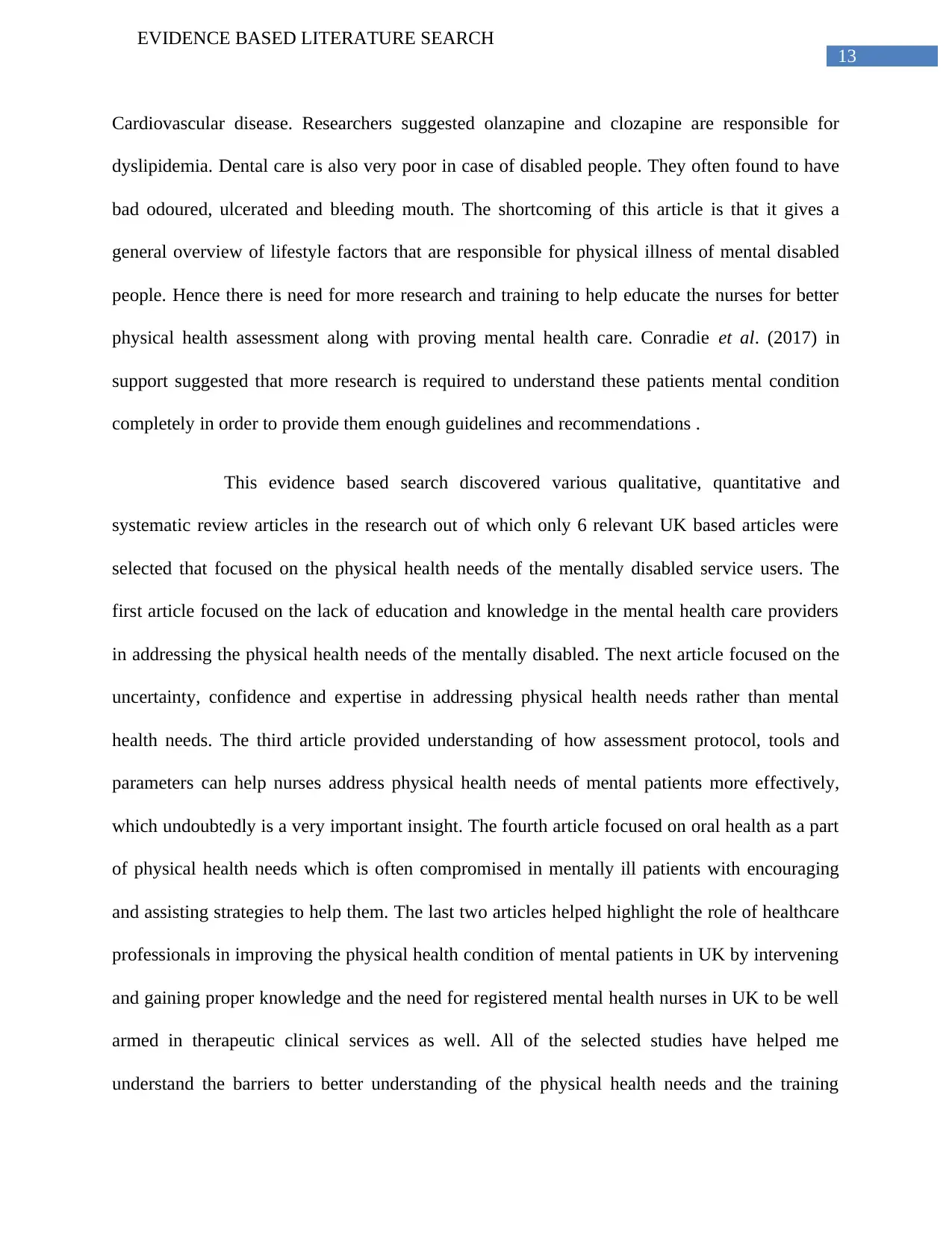
13
EVIDENCE BASED LITERATURE SEARCH
Cardiovascular disease. Researchers suggested olanzapine and clozapine are responsible for
dyslipidemia. Dental care is also very poor in case of disabled people. They often found to have
bad odoured, ulcerated and bleeding mouth. The shortcoming of this article is that it gives a
general overview of lifestyle factors that are responsible for physical illness of mental disabled
people. Hence there is need for more research and training to help educate the nurses for better
physical health assessment along with proving mental health care. Conradie et al. (2017) in
support suggested that more research is required to understand these patients mental condition
completely in order to provide them enough guidelines and recommendations .
This evidence based search discovered various qualitative, quantitative and
systematic review articles in the research out of which only 6 relevant UK based articles were
selected that focused on the physical health needs of the mentally disabled service users. The
first article focused on the lack of education and knowledge in the mental health care providers
in addressing the physical health needs of the mentally disabled. The next article focused on the
uncertainty, confidence and expertise in addressing physical health needs rather than mental
health needs. The third article provided understanding of how assessment protocol, tools and
parameters can help nurses address physical health needs of mental patients more effectively,
which undoubtedly is a very important insight. The fourth article focused on oral health as a part
of physical health needs which is often compromised in mentally ill patients with encouraging
and assisting strategies to help them. The last two articles helped highlight the role of healthcare
professionals in improving the physical health condition of mental patients in UK by intervening
and gaining proper knowledge and the need for registered mental health nurses in UK to be well
armed in therapeutic clinical services as well. All of the selected studies have helped me
understand the barriers to better understanding of the physical health needs and the training
EVIDENCE BASED LITERATURE SEARCH
Cardiovascular disease. Researchers suggested olanzapine and clozapine are responsible for
dyslipidemia. Dental care is also very poor in case of disabled people. They often found to have
bad odoured, ulcerated and bleeding mouth. The shortcoming of this article is that it gives a
general overview of lifestyle factors that are responsible for physical illness of mental disabled
people. Hence there is need for more research and training to help educate the nurses for better
physical health assessment along with proving mental health care. Conradie et al. (2017) in
support suggested that more research is required to understand these patients mental condition
completely in order to provide them enough guidelines and recommendations .
This evidence based search discovered various qualitative, quantitative and
systematic review articles in the research out of which only 6 relevant UK based articles were
selected that focused on the physical health needs of the mentally disabled service users. The
first article focused on the lack of education and knowledge in the mental health care providers
in addressing the physical health needs of the mentally disabled. The next article focused on the
uncertainty, confidence and expertise in addressing physical health needs rather than mental
health needs. The third article provided understanding of how assessment protocol, tools and
parameters can help nurses address physical health needs of mental patients more effectively,
which undoubtedly is a very important insight. The fourth article focused on oral health as a part
of physical health needs which is often compromised in mentally ill patients with encouraging
and assisting strategies to help them. The last two articles helped highlight the role of healthcare
professionals in improving the physical health condition of mental patients in UK by intervening
and gaining proper knowledge and the need for registered mental health nurses in UK to be well
armed in therapeutic clinical services as well. All of the selected studies have helped me
understand the barriers to better understanding of the physical health needs and the training
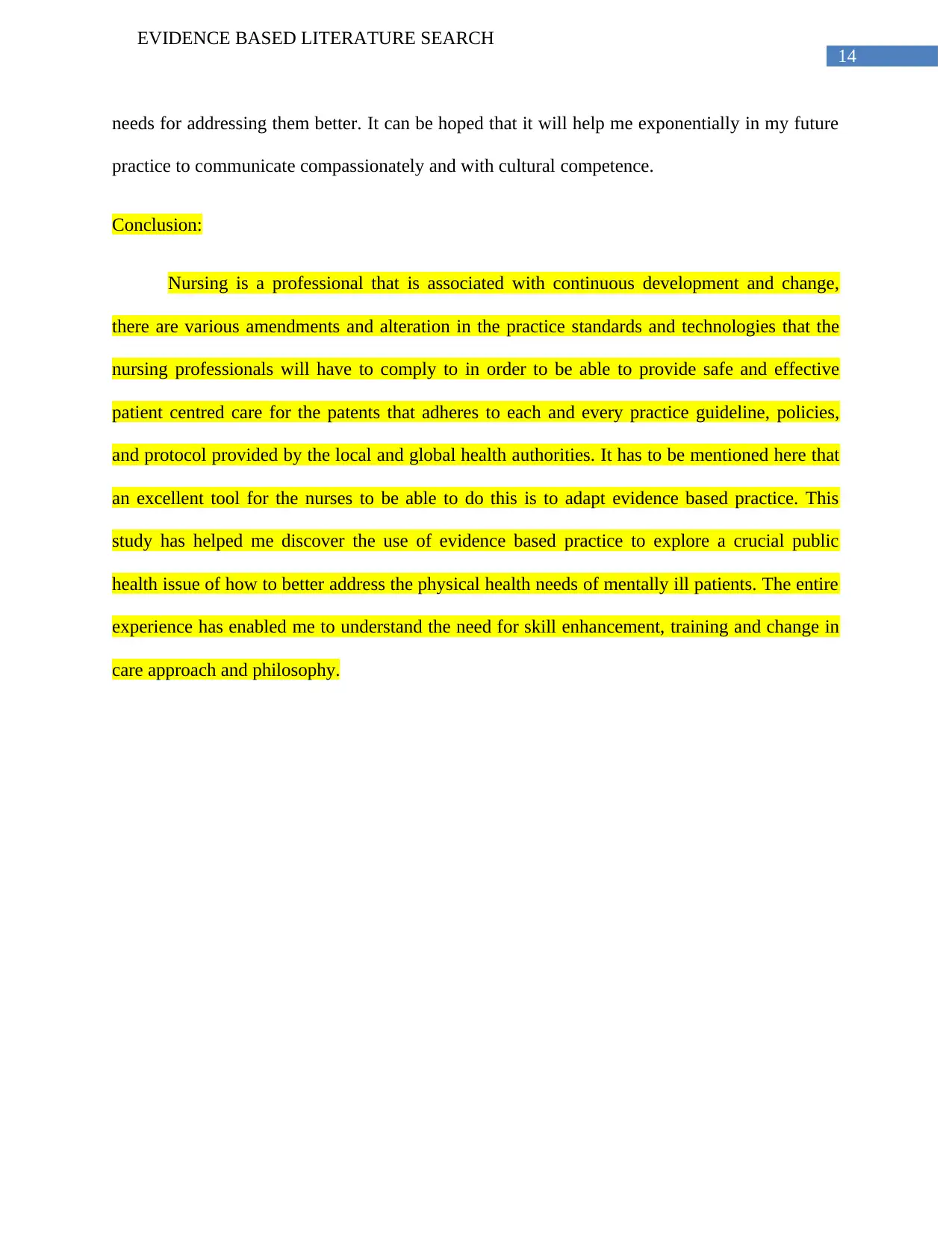
14
EVIDENCE BASED LITERATURE SEARCH
needs for addressing them better. It can be hoped that it will help me exponentially in my future
practice to communicate compassionately and with cultural competence.
Conclusion:
Nursing is a professional that is associated with continuous development and change,
there are various amendments and alteration in the practice standards and technologies that the
nursing professionals will have to comply to in order to be able to provide safe and effective
patient centred care for the patents that adheres to each and every practice guideline, policies,
and protocol provided by the local and global health authorities. It has to be mentioned here that
an excellent tool for the nurses to be able to do this is to adapt evidence based practice. This
study has helped me discover the use of evidence based practice to explore a crucial public
health issue of how to better address the physical health needs of mentally ill patients. The entire
experience has enabled me to understand the need for skill enhancement, training and change in
care approach and philosophy.
EVIDENCE BASED LITERATURE SEARCH
needs for addressing them better. It can be hoped that it will help me exponentially in my future
practice to communicate compassionately and with cultural competence.
Conclusion:
Nursing is a professional that is associated with continuous development and change,
there are various amendments and alteration in the practice standards and technologies that the
nursing professionals will have to comply to in order to be able to provide safe and effective
patient centred care for the patents that adheres to each and every practice guideline, policies,
and protocol provided by the local and global health authorities. It has to be mentioned here that
an excellent tool for the nurses to be able to do this is to adapt evidence based practice. This
study has helped me discover the use of evidence based practice to explore a crucial public
health issue of how to better address the physical health needs of mentally ill patients. The entire
experience has enabled me to understand the need for skill enhancement, training and change in
care approach and philosophy.
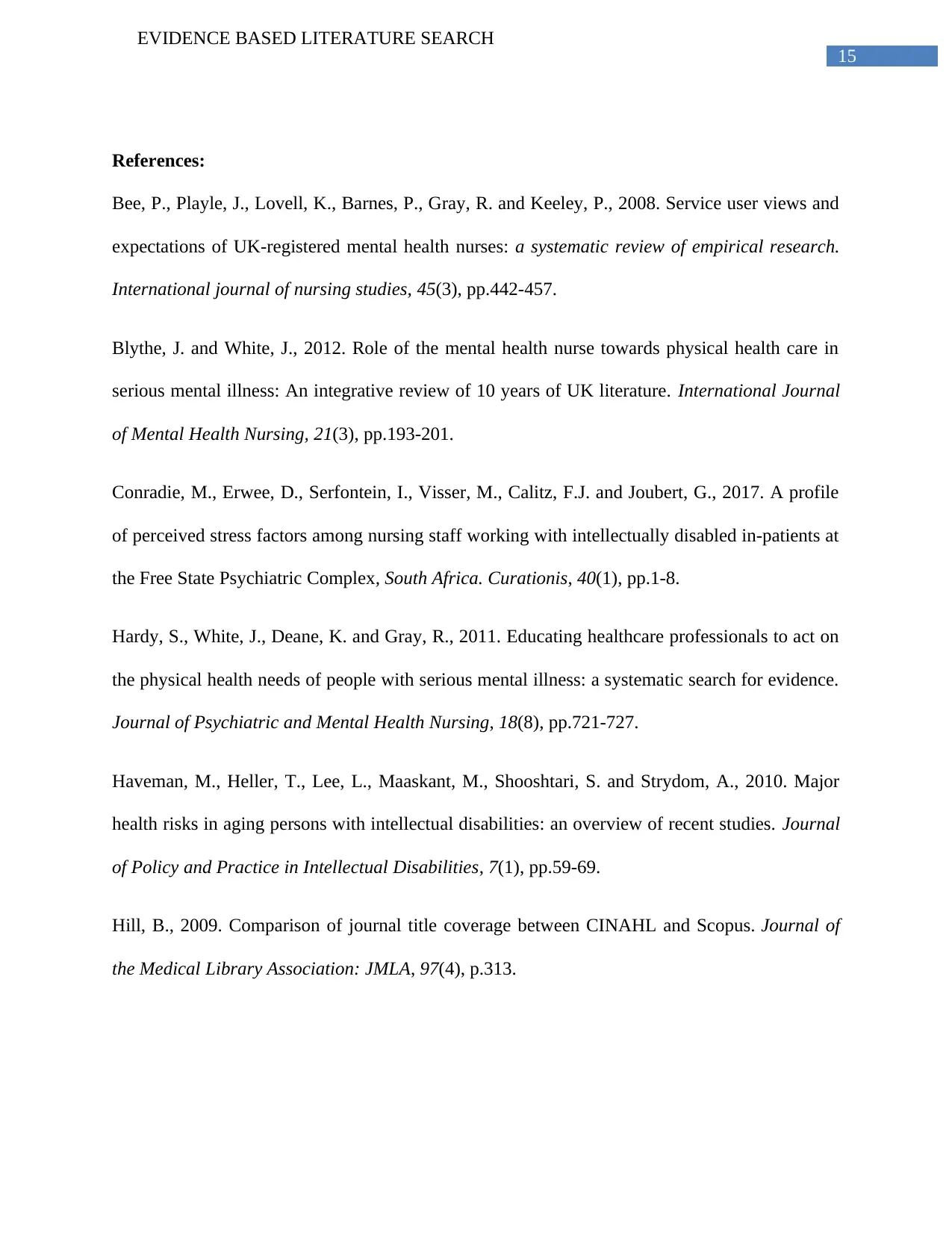
15
EVIDENCE BASED LITERATURE SEARCH
References:
Bee, P., Playle, J., Lovell, K., Barnes, P., Gray, R. and Keeley, P., 2008. Service user views and
expectations of UK-registered mental health nurses: a systematic review of empirical research.
International journal of nursing studies, 45(3), pp.442-457.
Blythe, J. and White, J., 2012. Role of the mental health nurse towards physical health care in
serious mental illness: An integrative review of 10 years of UK literature. International Journal
of Mental Health Nursing, 21(3), pp.193-201.
Conradie, M., Erwee, D., Serfontein, I., Visser, M., Calitz, F.J. and Joubert, G., 2017. A profile
of perceived stress factors among nursing staff working with intellectually disabled in-patients at
the Free State Psychiatric Complex, South Africa. Curationis, 40(1), pp.1-8.
Hardy, S., White, J., Deane, K. and Gray, R., 2011. Educating healthcare professionals to act on
the physical health needs of people with serious mental illness: a systematic search for evidence.
Journal of Psychiatric and Mental Health Nursing, 18(8), pp.721-727.
Haveman, M., Heller, T., Lee, L., Maaskant, M., Shooshtari, S. and Strydom, A., 2010. Major
health risks in aging persons with intellectual disabilities: an overview of recent studies. Journal
of Policy and Practice in Intellectual Disabilities, 7(1), pp.59-69.
Hill, B., 2009. Comparison of journal title coverage between CINAHL and Scopus. Journal of
the Medical Library Association: JMLA, 97(4), p.313.
EVIDENCE BASED LITERATURE SEARCH
References:
Bee, P., Playle, J., Lovell, K., Barnes, P., Gray, R. and Keeley, P., 2008. Service user views and
expectations of UK-registered mental health nurses: a systematic review of empirical research.
International journal of nursing studies, 45(3), pp.442-457.
Blythe, J. and White, J., 2012. Role of the mental health nurse towards physical health care in
serious mental illness: An integrative review of 10 years of UK literature. International Journal
of Mental Health Nursing, 21(3), pp.193-201.
Conradie, M., Erwee, D., Serfontein, I., Visser, M., Calitz, F.J. and Joubert, G., 2017. A profile
of perceived stress factors among nursing staff working with intellectually disabled in-patients at
the Free State Psychiatric Complex, South Africa. Curationis, 40(1), pp.1-8.
Hardy, S., White, J., Deane, K. and Gray, R., 2011. Educating healthcare professionals to act on
the physical health needs of people with serious mental illness: a systematic search for evidence.
Journal of Psychiatric and Mental Health Nursing, 18(8), pp.721-727.
Haveman, M., Heller, T., Lee, L., Maaskant, M., Shooshtari, S. and Strydom, A., 2010. Major
health risks in aging persons with intellectual disabilities: an overview of recent studies. Journal
of Policy and Practice in Intellectual Disabilities, 7(1), pp.59-69.
Hill, B., 2009. Comparison of journal title coverage between CINAHL and Scopus. Journal of
the Medical Library Association: JMLA, 97(4), p.313.
Secure Best Marks with AI Grader
Need help grading? Try our AI Grader for instant feedback on your assignments.
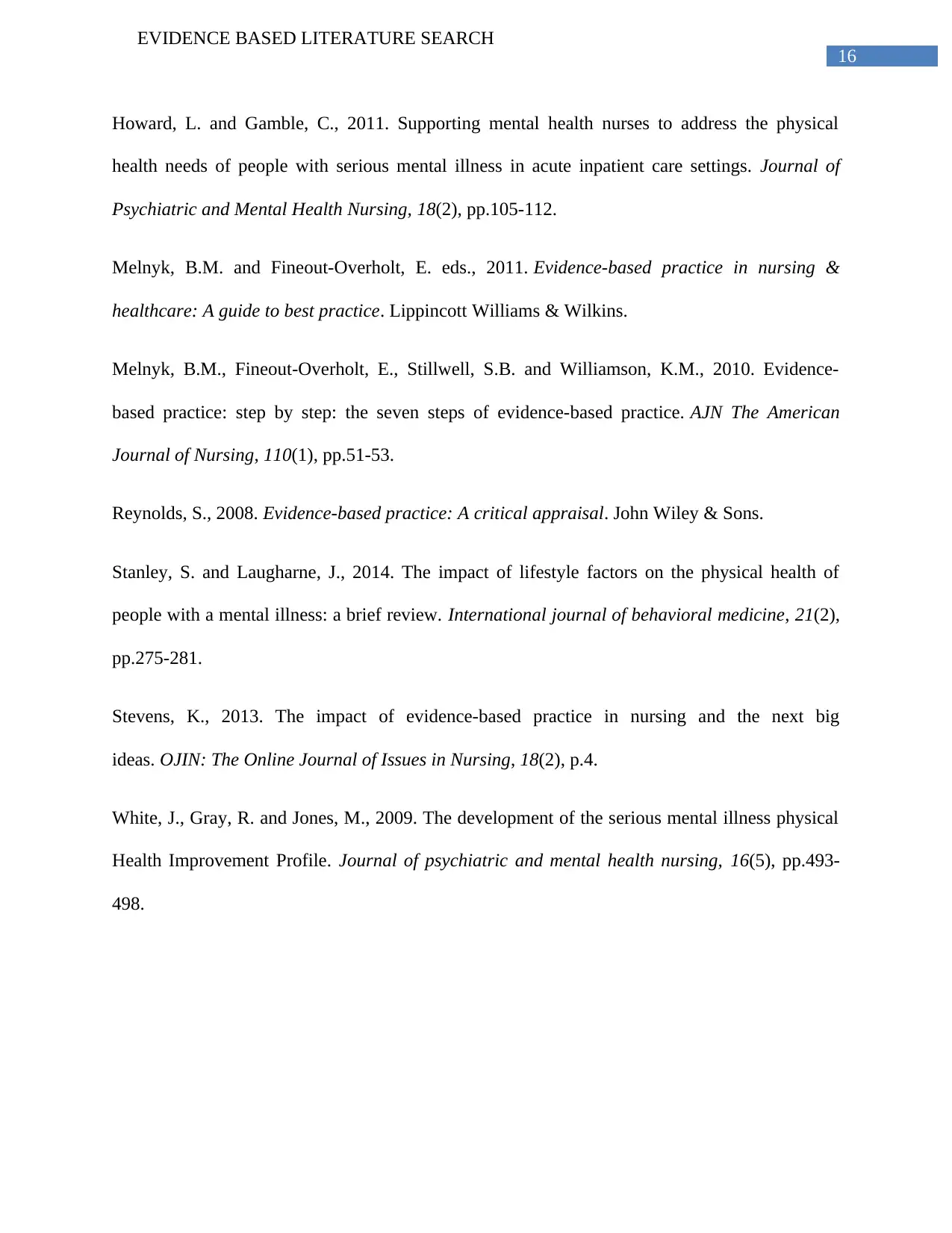
16
EVIDENCE BASED LITERATURE SEARCH
Howard, L. and Gamble, C., 2011. Supporting mental health nurses to address the physical
health needs of people with serious mental illness in acute inpatient care settings. Journal of
Psychiatric and Mental Health Nursing, 18(2), pp.105-112.
Melnyk, B.M. and Fineout-Overholt, E. eds., 2011. Evidence-based practice in nursing &
healthcare: A guide to best practice. Lippincott Williams & Wilkins.
Melnyk, B.M., Fineout-Overholt, E., Stillwell, S.B. and Williamson, K.M., 2010. Evidence-
based practice: step by step: the seven steps of evidence-based practice. AJN The American
Journal of Nursing, 110(1), pp.51-53.
Reynolds, S., 2008. Evidence-based practice: A critical appraisal. John Wiley & Sons.
Stanley, S. and Laugharne, J., 2014. The impact of lifestyle factors on the physical health of
people with a mental illness: a brief review. International journal of behavioral medicine, 21(2),
pp.275-281.
Stevens, K., 2013. The impact of evidence-based practice in nursing and the next big
ideas. OJIN: The Online Journal of Issues in Nursing, 18(2), p.4.
White, J., Gray, R. and Jones, M., 2009. The development of the serious mental illness physical
Health Improvement Profile. Journal of psychiatric and mental health nursing, 16(5), pp.493-
498.
EVIDENCE BASED LITERATURE SEARCH
Howard, L. and Gamble, C., 2011. Supporting mental health nurses to address the physical
health needs of people with serious mental illness in acute inpatient care settings. Journal of
Psychiatric and Mental Health Nursing, 18(2), pp.105-112.
Melnyk, B.M. and Fineout-Overholt, E. eds., 2011. Evidence-based practice in nursing &
healthcare: A guide to best practice. Lippincott Williams & Wilkins.
Melnyk, B.M., Fineout-Overholt, E., Stillwell, S.B. and Williamson, K.M., 2010. Evidence-
based practice: step by step: the seven steps of evidence-based practice. AJN The American
Journal of Nursing, 110(1), pp.51-53.
Reynolds, S., 2008. Evidence-based practice: A critical appraisal. John Wiley & Sons.
Stanley, S. and Laugharne, J., 2014. The impact of lifestyle factors on the physical health of
people with a mental illness: a brief review. International journal of behavioral medicine, 21(2),
pp.275-281.
Stevens, K., 2013. The impact of evidence-based practice in nursing and the next big
ideas. OJIN: The Online Journal of Issues in Nursing, 18(2), p.4.
White, J., Gray, R. and Jones, M., 2009. The development of the serious mental illness physical
Health Improvement Profile. Journal of psychiatric and mental health nursing, 16(5), pp.493-
498.
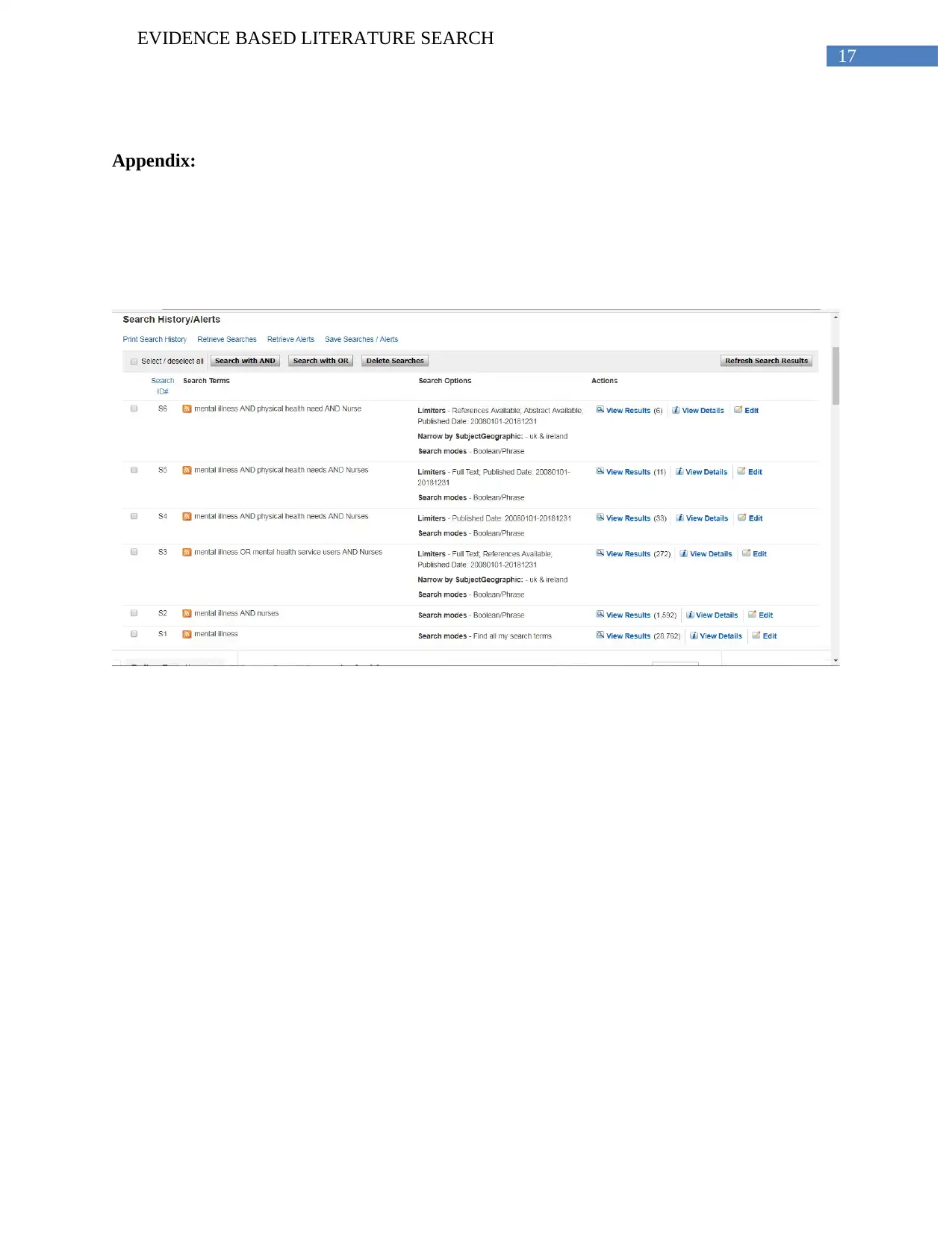
17
EVIDENCE BASED LITERATURE SEARCH
Appendix:
EVIDENCE BASED LITERATURE SEARCH
Appendix:
1 out of 18
Related Documents
Your All-in-One AI-Powered Toolkit for Academic Success.
+13062052269
info@desklib.com
Available 24*7 on WhatsApp / Email
![[object Object]](/_next/static/media/star-bottom.7253800d.svg)
Unlock your academic potential
© 2024 | Zucol Services PVT LTD | All rights reserved.





